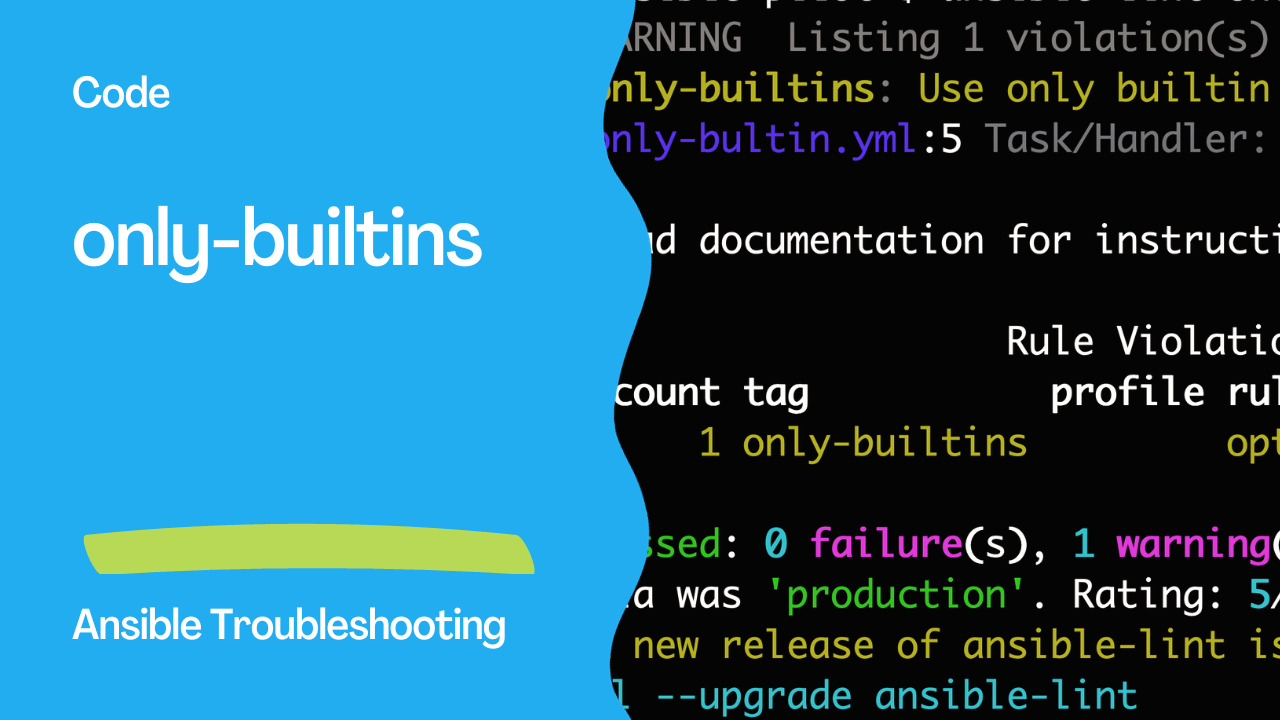Avoid Non-Builtin Actions in Your Ansible Playbooks
In the realm of Ansible playbooks, maintaining consistency and simplicity is key to a successful automation strategy. One way to achieve this is by adhering to the “only-builtins” rule, which emphasizes the usage of built-in actions from the ansible.builtin collection exclusively.
Keeping It Builtin
The “only-builtins” rule acts as a guardrail to ensure that you don’t inadvertently wander into using non-built-in collections, plugins, or modules within your Ansible playbooks. While Ansible’s ecosystem is rich with various extensions, sticking to the built-in collection can streamline your playbook’s structure and maintainability.
Enable the only-builtins Rule
You can enable this rule in your Ansible-lint configuration. By doing so, you instruct Ansible to validate only builtin modules.
Here’s how you can configure this rule:
enable_list:
- only-builtins
Problematic Code
---
- name: Example playbook
hosts: all
tasks:
- name: Deploy a Helm chart for Prometheus
kubernetes.core.helm: # <- Uses a non-builtin collection.
name: test
chart_ref: stable/prometheus
release_namespace: monitoring
create_namespace: true
In the problematic code above, we can see a playbook that attempts to deploy a Helm chart for Prometheus but uses the kubernetes.core.helm module, which is not part of the built-in ansible.builtin collection.
Ansible Lint Output
WARNING Listing 1 violation(s) that are fatal
only-builtins: Use only builtin actions. (warning)
only-bultin.yml:5 Task/Handler: Deploy a Helm chart for Prometheus
Read documentation for instructions on how to ignore specific rule violations.
Rule Violation Summary
count tag profile rule associated tags
1 only-builtins opt-in, experimental (warning)
Passed: 0 failure(s), 1 warning(s) on 1 files. Last profile that met the validation criteria was 'production'. Rating: 5/5 star

Correcting the Code
To adhere to the “only-builtins” rule, you should rewrite the playbook as follows:
- name: Example playbook
hosts: localhost
tasks:
- name: Run a shell command
ansible.builtin.shell: echo This playbook uses actions from the builtin collection only.
In the corrected code, we replaced the non-built-in kubernetes.core.helm module with a simple ansible.builtin.shell module, ensuring that we are using only built-in actions.
The Advantages
Consistency: Relying solely on built-in actions maintains a consistent codebase and makes it easier for other team members to understand and work on your playbooks.
Reduced Dependencies: You won’t have to manage external collections or plugins, simplifying your playbook’s requirements and dependencies.
Enhanced Maintainability: Playbooks based on the “
only-builtins” rule are less prone to breaking due to external collection updates, ensuring long-term maintainability.
By adopting the “only-builtins” rule, you’re setting yourself up for more effective and streamlined Ansible automation, which can lead to greater reliability and success in your infrastructure management tasks.
Conclusion
In conclusion, the “only-builtins” rule serves as a valuable guardrail in your Ansible playbook development. By adhering to this rule and using actions exclusively from the ansible.builtin collection, you ensure consistency and reliability in your automation scripts. This practice not only simplifies playbook maintenance but also reduces the chances of compatibility issues when upgrading Ansible or sharing your playbooks with others.
By focusing on using built-in Ansible modules, you harness the full power of the Ansible ecosystem and leverage features that are well-tested and supported. While external collections have their merits, this rule encourages the use of built-ins for a more streamlined and sustainable playbook development process.
To benefit from this rule, remember to enable it in your Ansible-lint configuration. Embracing “only-builtins” not only helps you write more robust playbooks but also contributes to the long-term stability and maintainability of your infrastructure automation.
Academy
Learn the Ansible automation technology with some real-life examples in my
Udemy 300+ Lessons Video Course.

My book Ansible By Examples: 200+ Automation Examples For Linux and Windows System Administrator and DevOps

Donate
Want to keep this project going? Please donate
